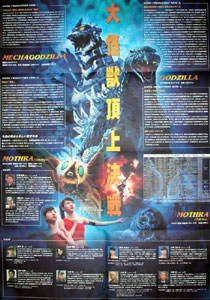
GMMG:
Tokyo SOS
Tokyo International Film Festival
November 3, 2003
By Norman England
Disclaimer: This review is intended as entertainment. The opinions expressed are mine and mine alone. I don’t claim my take on GMMG or Godzilla to be be-all and end-all interpretations. I also don’t claim any right to the name Godzilla or the other monsters appearing in this article. They are owned, of course, by those who hold the copyright to them. Anyway… should you find yourself in disagreement with anything within this article, I ask that you stop reading, draw a hot bath, and sit in it for an hour. You’ll feel better for sure.
The
Show:
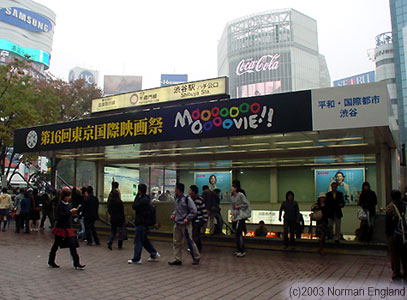 This
past Monday (3 November 2003) marked not only the premiere of the latest Godzilla
film—Godzilla - Mothra - Mechagodzilla: Tokyo SOS—at the sixteenth
annual Tokyo International Film Festival, but was also the forty-ninth anniversary
of the release of the very first Godzilla movie. Though a fictional character,
Godzilla has so ingrained itself on viewers that fans and parent company Toho
Motion Pictures Inc have come to designate this day as the birthday of the
radiation spawned behemoth. So, between the two events, this day held special
significance in the history of Godzilla, and was another in a long line of
exciting TIFF shows.
This
past Monday (3 November 2003) marked not only the premiere of the latest Godzilla
film—Godzilla - Mothra - Mechagodzilla: Tokyo SOS—at the sixteenth
annual Tokyo International Film Festival, but was also the forty-ninth anniversary
of the release of the very first Godzilla movie. Though a fictional character,
Godzilla has so ingrained itself on viewers that fans and parent company Toho
Motion Pictures Inc have come to designate this day as the birthday of the
radiation spawned behemoth. So, between the two events, this day held special
significance in the history of Godzilla, and was another in a long line of
exciting TIFF shows.
TIFF is held in the Shibuya ward of Tokyo, a couple of minutes by foot from the JR Shibuya station. As usual, the screening was at Bunka Mura’s Orchard Hall, with this year’s show set for an early 12:30 p.m. start. Though seats of late are assigned rather than the first come first served basis they were up until GMK, there was still a long line of eager fans queued before the theater. Many had come from across Japan (in some cases even outside Japan). While TIFF is primarily attended by professionals in the film business, for this screening they were easily out numbered by regular, off-the-street Godzilla fans. Kiryu JXSDF / MFS-3 caps and Godzilla T-shirts were abundant, denoting attendees’ allegiance to the King of the Monsters. After opening at noon, the hall filled up fast. And soon things were underway.
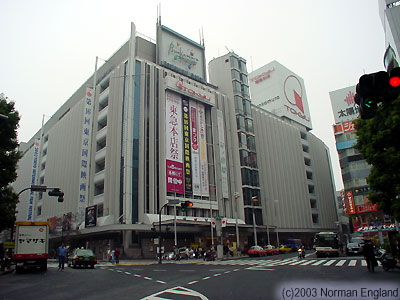 Following
the TIFF emcees’ introduction to the show (one speaking Japanese, the
other translating into English), the main cast and upper staff of GMMG were
called on to give welcoming speeches. This year’s TIFF set a record
for presenters, with a whooping total of ten taking the stage. All stepped
out to thunderous applause. Standing from left to right were producer Shogo
Tomiyama, Shobijin actresses Chihiro Ohtsuka and Masami Nagasawa, actor Mitsuki
Koga, lead actor Noboru Kaneko, actor Akira Nakao, actor Hiroshi Koizumi,
actor Kou Takasugi, FX director Eiichi Asada, and last but certainly not least,
director Masaaki Tezuka.
Following
the TIFF emcees’ introduction to the show (one speaking Japanese, the
other translating into English), the main cast and upper staff of GMMG were
called on to give welcoming speeches. This year’s TIFF set a record
for presenters, with a whooping total of ten taking the stage. All stepped
out to thunderous applause. Standing from left to right were producer Shogo
Tomiyama, Shobijin actresses Chihiro Ohtsuka and Masami Nagasawa, actor Mitsuki
Koga, lead actor Noboru Kaneko, actor Akira Nakao, actor Hiroshi Koizumi,
actor Kou Takasugi, FX director Eiichi Asada, and last but certainly not least,
director Masaaki Tezuka.
Mr. Tomiyama, adept at TIFF, was in top form. He was pleased to announce that for the first time a Godzilla film was fully completed for TIFF. What you see today, he beamed, is what you’ll see when it begins its run in Japan later next month. Lead actor Noboru Kaneko was much more articulate than during production press events. A cheerful man with boyish good looks, Mr. Kaneko is enjoying his first lead in a motion picture. It is only natural, then, that he be given time to accustom himself to the media circus surrounding high profile films such as Godzilla.
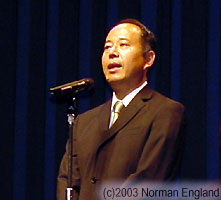
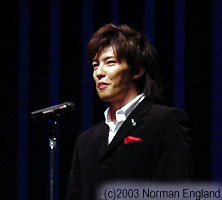
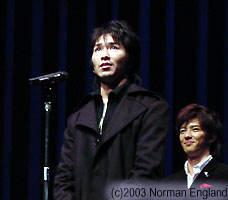
As usual, actor Akira Nakao received the biggest laughs. The man is just naturally funny and is extremely comfortable being in the spotlight. He mentioned that despite it being election time in Japan (a reference to his playing the prime minister of Japan), he has chosen to attend TIFF rather than election drives. Why? Because Godzilla is much more important! The audience roared with approval.
Whereas
Mr. Nakao is utterly at ease on stage, the same could not be said for Shobijin
actress Masami Nagasawa. She was visibly shaking when speaking to the audience.
Her counterpart, Chihiro Ohtsuka, was much more at ease. For the show, Ms.
Ohtsuka wore a very adorable outfit with a large red heart embroidered on
the chest.
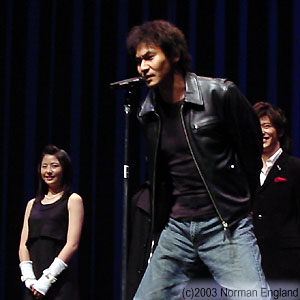
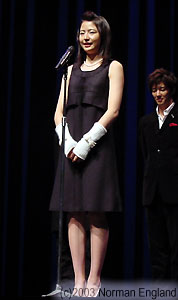
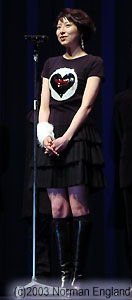
FX director (announced here as the film’s technical advisor) Asada presented a very down to earth speech that in my eyes illustrated the philosophical difference between old and new school filmmakers. Finally, director Tezuka gave a nice, heartfelt greeting. He looked genuinely happy with the show’s turn out. Standing tall, Mr. Tezuka appeared entirely confident with his film that was just minutes off from its first ever public showing.
Following this was the mandatory appearance of Godzilla and Mechagodzilla. Wearing bow ties, the two put on a simulated battle for the audience. White smoke blasted out of Godzilla as the two did their best to give the audience a taste of what was to come in the film. With this done, the group posed for the twenty or so reporters squatting in front of the stage.
Usually
this part of the show clocks in at under a half-hour. Today things went a
bit longer, due no doubt to the unusually large number of staff and cast on
stage. The entire ceremony lasted nearly 40 minutes.
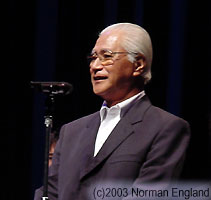
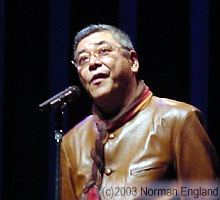
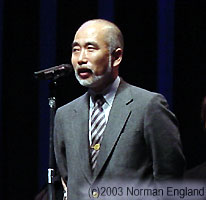
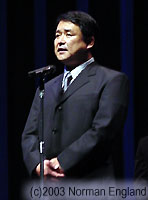
The
Film:
After this came the
screening of GMMG: Tokyo SOS. I’m going to skip a detailed story synopsis
as I don’t believe in giving away too much beforehand (I absolutely
loath spoilers), but here is the gist of the film:
A strange signal is noted on a US radar station in Hawaii. Heading for Japan, the bogy is intercepted by the Japanese air force. Engaging it, the pilots are startled to see a strange colorful wing breaking through the clouds.
In a cabin in a snowy section of Japan, vacationing Shinichi Chujo is visited by the Shobijin. Though forty odd years since their last meeting, the amenity of the reunion is overshadowed by the tiny girls’ plea, as, speaking in unison, the two beg him to see to it that Japan return Godzilla’s bones to the sea. Their case is simple: if Japan does not, Godzilla will continue to seek revenge for the abomination against its species and will ravage the nation until it complies. It so happens that Chujo’s grandson, Yoshito Chujo, is on the ground crew of Mechagodzilla, Japan’s super weapon built around the bones of the original Godzilla. A machine fanatic, Yoshito defends Japan’s right to MG. Yet the Shobijin protest and insist that its existence is what puts Japan in jeopardy. They add that should Japan do the right thing and return the bones to their watery resting place, they will pledge Mothra’s protection against Godzilla.
Despite the older Chujo’s appeal to the prime minister, the Japanese leader refuses to scrap the MG project, which is nearing completion of repairs from last year’s battle against Godzilla. Though sympathetic of the quandary, the concern is that Mothra cannot be trusted since the creature laid waste to Tokyo forty years prior.
As prophesied
by the twin fairies, when MG is reactivated it serves as a calling card to
Godzilla, and the monster heads immediately toward the MG base in Hachioji.
Maser tanks are called in to contain Godzilla at Shinagawa, while Mothra is
summoned by Chujo. But with whom will Mothra side? Godzilla? Mechagodzilla?
The fate of Japan hangs in the balance...
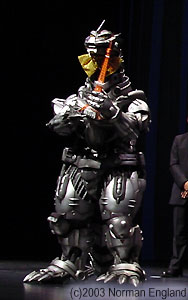
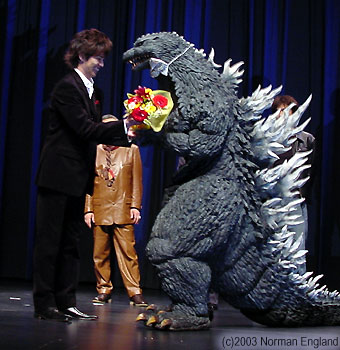
The
Analysis:
First off, the story
of GMMG is simple. Like last year’s, it exists to emphasize a point.
Where GxMG was built around the theme “life is precious,” this
time the message is “life should be lived within the age into which
it is born.” I can’t recall the exact quote as I didn’t
jot it down (sorry, I was too engrossed in the film), but the point is that
the reuse of Godzilla bones within MechaGodzilla is an abomination against
the laws of nature. As was the case with atomic weapons and the resulting
birth of Godzilla, it is when man ventures into the realm of God that the
repercussions of his actions will be felt. The aim of the story is to illustrate
this thought.
The acting and direction are by far the best of any Tezuka film to date. Koizumi is very much on the mark as the elderly Chujo and easily steals the show. His role is the most successful link in a modern entry to Godzilla films of yore. The lead role played by Kaneko is handled competently, though don’t expect him to walk away with any acting citations. Tezuka wisely chooses to avoid moments where he would be called on to display any heavy acting. The scene I’m thinking of is one where the younger Chujo must decide between his loyalty to his grandfather or his love of Mechagodzilla. Tezuka skips the moment of decision, which is probably for the best. This remark is meant as no insult to Kaneko. As his first leading role, the twenty-nine year old openly admits to his limitations and considers himself lucky for the chance to improve his range as an actor. With that said, I feel that he is fine in the role.
Miho Yoshioka, while handling the second billed role of MG copilot Azusa Kisaragi well, comes across as unnecessary. Her scenes seem hurried and are neither here nor there where the story is concerned. It’s as if she is merely included to show that Godzilla productions can attract young stars on the upswing of popularity. Her nonparticipation in GMMG press conferences and the TIFF presentation only lends strength to the claim that she has little concern for the production. Ms. Yoshioka’s character is a tad confusing too. She seems to exist only as a love interest for Chujo (they worked together years earlier). There seems to be some kind of rivalry for her between Kaneko and cocky MG head pilot Kyosuke Akiba (Mitsuki Koga), but this thread never really develops. This is not so much a problem with GMMG as it is with Japanese cinema in general, which has a radically different sense of cinematic romance from that of other nations.
Fans of last year’s GxMG will be happy to learn that Yumiko Shaku makes a brief cameo, giving us another taste of her one-dimensional character. Also on board for cameos are two members of last year’s MG crew. The explanation of why they are not a part of the MG staff this time around is that the three are departing for the US to study advanced military strategy. Personally, I find it embarrassing that in Godzilla films America is always only thought of in terms of its military. However, this point accurately reflects the Japanese view of America as a country obsessed with military might.
The Shobijin are neat. The latest pair, while not able to hold a candle to the original “Peanuts,” is possibly the best reincarnation since the old days (better even than *gasp* Pair Bambi!). Their inclusion in the film works well and adds a nice touch of fantasy, which is just as important to Godzilla films as is the science fiction aspect. Utilizing modern composite techniques, they are convincingly dropped into their scenes. For me, this is a double-edged sword. On the one hand, it makes for very realistic shots; on the other, fans of film props are denied a chance to see the artistry of giant renderings of table top items such as phones and pencils. Their singing of the Mothra song is handled very well, too. It is brief enough not to bring the film to a screeching halt, as was the case when used in the 1990s.
As for GMMG's giant monsters:
Over all, Godzilla is handled much better than last year’s outing. While still a bit undefined for my tastes, the Tezuka Godzilla is more active and driven than in any of the non-GMK Millennium entries. FX director Asada gets the most out of the material and brings an old school sensibility to the modern film stage. During his opening speech, Mr. Asada pointed out that the GMMG Godzilla never attacks first. This is to suggest that the Tezuka Godzilla harbors no real ill will against mankind, only against the follies of man.
“Tom” Kitagawa’s portrayal of Godzilla is consistent with his previous performances. While not as nuanced as either Haruo Nakajima or Ken Satsuma, he puts in a solid bid that neither advances nor disservices the legacy of Godzilla. His battles against adversaries Mothra (both flying and larva), Mechagodzilla and mankind are fought well, and he gives his all to bring life to a creature of unmitigated power. Despite the respite taken during GMK, Tom is the one who will be remembered as the Godzilla actor of the Millennium era.
Of course, there will no doubt be those who will try to twist the Godzilla presented in GMMG to fit their own lame agenda or take on Godzilla. Either using it to support their personal belief of what Godzilla means, or their idea of what Godzilla doesn’t mean. As Mr. Tezuka mentioned to me during editing, “Ask one hundred Godzilla fans to define Godzilla and you’ll get one hundred different answers.” For GMMG, the Godzilla is clearly not the original, and may even be one of several that have plagued Japan over the years. But, no matter how you slice it, Godzilla has gone through enough changes and alterations during the past forty-nine years to show that anyone trying to peg Godzilla into a single behavioral slot is not operating at full brain capacity. Without mincing words, let me say that I enjoy all of the Millennium Godzillas. All give me pause to consider the greater meaning of Godzilla.
Kiryu, or Mechagodzilla, is less in the spotlight than last year’s GxMG. For what seems like most of the movie, it sits around in a disabled state. In the film, the creator of MG’s previous ace-in-the-hole weapon, the Absolute Zero Cannon, states that he needs a diamond roughly the size of a man to rebuild the weapon. Unable to procure one, a new weapon is added called the Hyper Maser (which for some reason was written as Hiper Maser in the subtitles). A triple maser that shoots out of its chest, it is made all the more devastating when MG adds in its twin mouth masers. MG also sports some new accessories, such as a drill hand that does a real number on Godzilla following their crash into the Diet building.
However, it is probably Mothra who steals the show. In the adult stage, it is magnificent. Its wing colors are vivid, and its mouth and leg movements are entirely convincing. When Mothra releases its powder on Godzilla, this too is handled well. The wing flaps (powered by my buddy Tony) are quick and strong. And when Mothra suffers extensive battle damage, leaving it covered with gray dust and torn wings, its movements convincingly reflect its pain. In GMMG, the adult Mothra regains its title of most eloquent kaiju. The larva Mothras, too, are superb. Their sculpting and execution are as near to perfect as is possible. Suit builder Shinichi Wakasa and his crew at Monsters Inc really outdid themselves this time around. One thing I am happy to see included is the far-too-long absent shots of Mothra spinning web. For GMMG we are given several such scenes.
There is also a surprisingly high amount of kaiju crashing into buildings. In fact, everyone is given a least one building to fall into full weight. For this kind of stuff—city destruction—there is possibly much more going on here than in any other film in the Millennium series. Also, the miniature work is up to its usual high standards. Often the art staff’s work is at the mercy of the director. For GMMG, due to the on-the-mark direction of Asada and an improvement over the ofttimes shoddy composite work of GxMG, the quality of the efforts of art director Toshio Miike and his able-bodied staff is fully realized.
Orchard
Hall, which normally has the worst sound acoustics around, seems to have been
refit with a new sound system. Where once it was crashing echoes that reduced
the music to a tinny facsimile of the soundtrack, for this screening the sound
rocked. After the show, everyone was talking about how surprised at last they
were to see a Godzilla film at TIFF where they didn’t have to dismiss
the music until its official opening. With that said, I have to admit to not
being a big Michiru Ohshima fan. I find all the rousing trumpeting reminiscent
of old time gladiator movies. However, if a fan of her work then I’m
sure you’ll be pleased with what is offered as it is entirely in line
with her past Godzilla work.
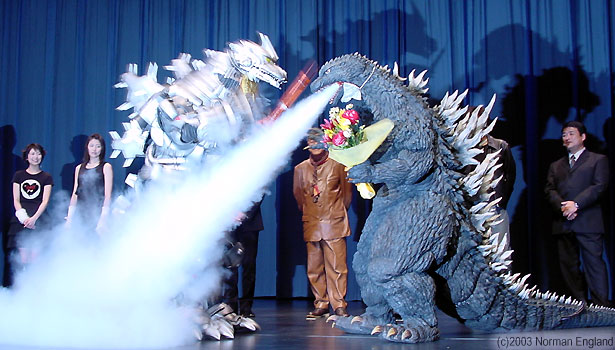
The
After Screening Festivities:
The screening was
attended by a Who’s Who of the Japanese kaiju world. Gamera and GMK
director Shusuke Kaneko was there with children in tow; SFX supervisor par
excellence Hajime Matsumoto took time off from his Tetsujin 28 duties to come,
Heisei Godzilla FX chief Koichi Kawakita was on hand, as were Godzilla 2000
/ GxM FX director Kenji Suzuki, GMK Godzilla suit actor Mizuho Yoshida, founding
Godzilla suit actor Haruo Nakajima, and model maker Hiroshi Sagae, to name
just a few. Many of the GMMG staff turned out to see how their latest went
over as well. There was suit maker Shinichi Wakasa, art director Toshio Miike,
Asada assistant director Toshifumi Shimizu, Tezuka assistant director Hideaki
Murakami, FX cameraman Kenichi Eguchi, soundman Teiechi Saito, and many others
too numerous to fully list. In addition to the actors who presented the show,
several others from GMMG came, such as military head Akira Nakahara who has
been with the series since GMK. Following the screening, fans clamored around
the stars as they made their way out of the hall, seeking autographs on the
day’s program, a colorful foldout poster with movie info and photos.
(See scan below.)
The annual after party show put on by Japan’s “Godzilla Supporters” was great fun. Often, this is the only chance many of us get to see each other all year. In particular, webmaster Hico and his wife (though I did catch up with them one day on the set this past summer). It was nice to chat with Haruo Nakajima, and he wasted no time making it clear that suit actors today don’t possess the right stuff as they did in his day. He also brought up Jim Cirronella, who he knew so much about, relating Jim's musical aspirations and facts about his wife, that I had to kid Mr. Nakajima and ask if he wasn’t writing a bio on the former AFFE organizer.
Being Japan, there is no way around Bingo, and cards were passed around about half way through the party. There were many neat prizes, all Godzilla related, of course. But more fun than playing was hearing what name the winner would come up with when claiming a prize. Everyone choose far out names from the history of Godzilla. Someone beat me to Nick Adams, so I settled on Maki Goro from Son of Godzilla.
Several GMMG staffers came too, including FX director Asada and suitmaker Wakasa. While a tad short, Mr. Wakasa makes up for this with a larger-than-life personality. He’s great fun, and I have to say that one thing I appreciate about Mr. Wakasa is the attention he always heaps on my friend and assistant Nobuko Ohmachi, who flew in from Osaka for today’s show. It really puts the recent scathing remarks of pathetically jealous fan boys into proper perspective.
Other attendees were my buddies from Uchusen, Tomoi and Shimazaki, who are doing this year’s reports on GMMG for the popular science fiction magazine. Though in a sense my rivals, as I do the pieces for Hobby Japan, we are all grown up to know that there is enough Godzilla to go around for all. One thing I enjoy about the two, too, is that both have different ideas of what makes Godzilla Godzilla. Basically, Tomoi prefers the Kaneko Godzilla and Shimazaki the Tezuka. Despite this, the team is able to use their difference of opinion to their advantage, and their work is all the richer for it.
One of the more pleasant moments was talking with fan-gone-pro designer Shinji Nishikawa. I believe his redesigns of Mechagodzilla to be very well imagined. He mentioned his complete satisfaction with this year’s film and glanced to Mr. Asada sitting across from us as a vote of confidence in the director’s execution of this year’s effect sequences. Mr. Nishikawa is now working with Kenji Suzuki (who was also at the party) on a hero TV show.
It was enjoyable to relax with FX director Asada. For me, there is always a certain amount of trepidation involved in getting to know a new FX director. I was pleased to learn over the course of the GMMG production that Mr. Asada is a man of no pretension. Of the three FX directors that have overseen this end of Tezuka’s Godzilla production, Asada is the one who has best complemented the director’s vision of Godzilla.
Overall, another inspired day is added to the lore of Godzilla history.
To sum up, where past Tezuka efforts were received by fans with decidedly mixed results, the reaction to GMMG following TIFF was unanimously positive. I’d say that the worst comment I heard was that it was more of the same as last year, only better. Me, I think I can live with that sort of criticism. Most agreed that this is by far Tezuka’s most polished Godzilla to date. With this, I wholly concur. GMMG is a marked improvement over last year’s film, which I found rather flat.
On a personal side note, GMMG represents a rite of passage for me. While I have spent years doing various odd jobs during the Godzilla productions, it hasn’t been until this film that I have received onscreen credit. I’m proud to say that I am listed in the cast of GMMG, the result of a VERY minor speaking part (don’t blink when you finally see the film!). Rather than the result of this sole stint, I view it as Mr. Tezuka’s way of saying thanks for my on and off set contributions. My appreciation of Mr. Tezuka, his work, and his constant drive to improve upon each of his Godzilla films leaves me with nothing but respect for the man. I look forward to his future involvement with the one-year-shy-of-fifty Godzilla series.
